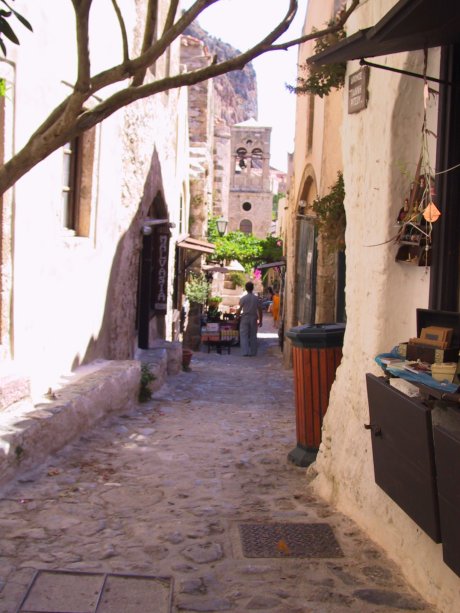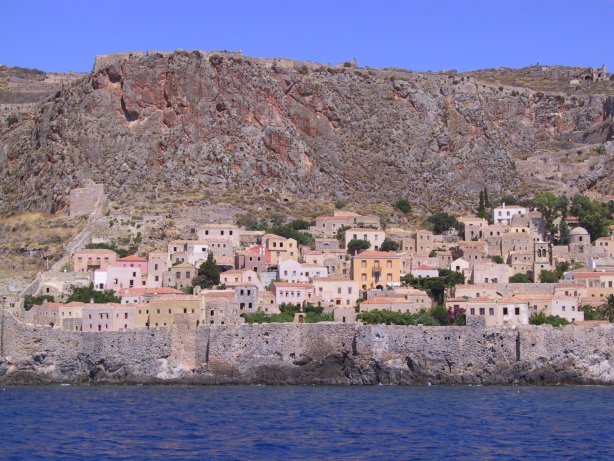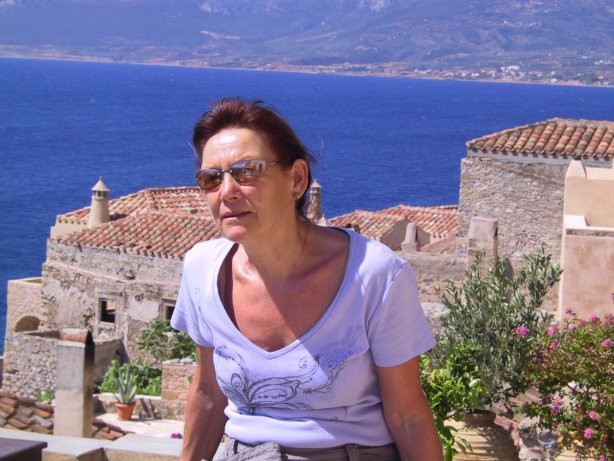Monemvasia
 Walled town
Monemvasia is the Gibraltar of Greece - a massive rock rising drastically from the sea just off the east coast. It is reached by a causeway from the mainland village of village of Gefyra (also called Nea Monemvasia). In summer, Gefyra and Monemvasia brim with tourists, but the extraordinary impact of one's first encounter with the medieval town of Monemvasia – and the delights of exploring it - override the effects of mass tourism. The poet Yiannis Ritsos who was born and lived for many years in Monemvasia, wrote of it: “This scenery is as harsh as silence.”
Walled town
Monemvasia is the Gibraltar of Greece - a massive rock rising drastically from the sea just off the east coast. It is reached by a causeway from the mainland village of village of Gefyra (also called Nea Monemvasia). In summer, Gefyra and Monemvasia brim with tourists, but the extraordinary impact of one's first encounter with the medieval town of Monemvasia – and the delights of exploring it - override the effects of mass tourism. The poet Yiannis Ritsos who was born and lived for many years in Monemvasia, wrote of it: “This scenery is as harsh as silence.”
 Monemvassia from the sea
From Gefyra, Monemvasia is a huge rock topped by a fortress with a few buildings scattered at sea level. But cross the causeway and follow the road that curves around the side of the rock and you will come to a narrow tunnel in a massive fortifying wall. The tunnel is L-shaped so you cannot see the other side until you emerge, blinking into the magical town of Monemvasia, conceled until that moment. Monemvasia;s houses are inhabited, mostly by weekenders from Athens.
Monemvassia from the sea
From Gefyra, Monemvasia is a huge rock topped by a fortress with a few buildings scattered at sea level. But cross the causeway and follow the road that curves around the side of the rock and you will come to a narrow tunnel in a massive fortifying wall. The tunnel is L-shaped so you cannot see the other side until you emerge, blinking into the magical town of Monemvasia, conceled until that moment. Monemvasia;s houses are inhabited, mostly by weekenders from Athens.
 Tan
Tan
The island of Monemvasia was part of the mainland until it was separated by an earthquake in AD 375. Its name means 'single entry' (moni - single, emvasia - entry), as there is only one way to the medieval town. During the 6th century, barbarian incursions forced inhabitants of the surrounding area to retreat to this natural rock fortress. By the 13th century, it had become the principal commercial centre of Byzantine Morea - complementary to Mystras, the spiritual centre. It was famous throughout Europe for its highly praised Malvasia wine. Later came a succession of invasions Franks, Venetians and Turks. During the War of Independence, its Turkish inhabitants were massacred on their surrender following a three-month siege.